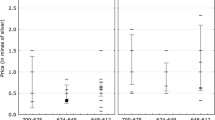Abstract
The Ubaid period was characterized by major climatic changes. During the beginning of this period, summers would have been somewhat hotter than today. Winter temperatures would have been colder. The beginning of the Ubaid Tradition was also marked by a wet monsoonal climatic regime, with rainfall beginning earlier in the fall and ending later in the spring. By the end of the Ubaid tradition, climatic conditions were well on their way toward modern values, with perhaps slightly higher annual temperatures and greater aridity at the end of the Ubaid than today. In northern Mesopotamia, annual seasonality appears to have been extreme. Summers were intensely arid. During the winter, violent rainstorms resulted in erosion of dry soils, incision of wadis, and possible destruction of settlements.
Access this chapter
Tax calculation will be finalised at checkout
Purchases are for personal use only
Preview
Unable to display preview. Download preview PDF.
Similar content being viewed by others
Suggested Readings
Allchin, F. R. (1985). “The Interpretation of a Seal from Chanhu-daro and Its Significance for The religion of the Indus Valley.” In South Asian Archaeology 1983, ed. J. Schotsmans and M. Taddei. Naples: Instituto Universitario Orientale, Dipartimento di Studi Asiatici, Series Minor 23, 369-384.
Dhyansky, Yan Y. (1987). “The Indus Valley Origin of a Yoga Practice.” Artibus Asiae 48, 1-2: 89-108.
Hiltebeitl, Alf (1978). “The Indus Valley “Proto-Siva,” Reexamined through Reflections on the Goddess, the Buffalo, and the Symbolism of Vahanas.” Anthropos. 73: 767-797.
Marshall, Sir John, ed. (1931). Mohenjo-Daro and the Indus Civilization, 3 vols. London: Arthur Probsthain.
McEvilley, Thomas (1981). “An Archaeology of Yoga.” Res 1: 44-77.
Puhvel, J. (1987). Comparative Mythology. Baltimore and London: John Hopkins University Press.
Wheeler, Sir Mortimer (1968). The Indus Civilization, 3d ed. Supplementary Volume to the Cambridge History of India. Cambridge: Cambridge University Press.
Author information
Authors and Affiliations
Editor information
Editors and Affiliations
Rights and permissions
Copyright information
© 2002 Springer Science+Business Media New York
About this chapter
Cite this chapter
Peasnall, B. (2002). Ubaid. In: Peregrine, P.N., Ember, M. (eds) Encyclopedia of Prehistory. Springer, Boston, MA. https://doi.org/10.1007/978-1-4615-0023-0_37
Download citation
DOI: https://doi.org/10.1007/978-1-4615-0023-0_37
Publisher Name: Springer, Boston, MA
Print ISBN: 978-1-4684-7135-9
Online ISBN: 978-1-4615-0023-0
eBook Packages: Springer Book Archive




